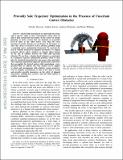Provably Safe Trajectory Optimization in the Presence of Uncertain Convex Obstacles
Author(s)
Dawson, Charles; Jasour, Ashkan; Hofmann, Andreas; Williams, Brian
DownloadSubmitted version (845.4Kb)
Open Access Policy
Open Access Policy
Creative Commons Attribution-Noncommercial-Share Alike
Terms of use
Metadata
Show full item recordAbstract
© 2020 IEEE. Real-world environments are inherently uncertain, and to operate safely in these environments robots must be able to plan around this uncertainty. In the context of motion planning, we desire systems that can maintain an acceptable level of safety as the robot moves, even when the exact locations of nearby obstacles are not known. In this paper, we solve this chance-constrained motion planning problem using a sequential convex optimization framework. To constrain the risk of collision incurred by planned movements, we employ geometric objects called ϵ-shadows to compute upper bounds on the risk of collision between the robot and uncertain obstacles. We use these ϵ-shadow-based estimates as constraints in a nonlinear trajectory optimization problem, which we then solve by iteratively linearizing the non-convex risk constraints. This sequential optimization approach quickly finds trajectories that accomplish the desired motion while maintaining a user-specified limit on collision risk. Our method can be applied to robots and environments with arbitrary convex geometry; even in complex environments, it runs in less than a second and provides provable guarantees on the safety of planned trajectories, enabling fast, reactive, and safe robot motion in realistic environments.
Date issued
2020Department
Massachusetts Institute of Technology. Department of Aeronautics and AstronauticsJournal
IEEE International Conference on Intelligent Robots and Systems
Publisher
Institute of Electrical and Electronics Engineers (IEEE)
Citation
Dawson, Charles, Jasour, Ashkan, Hofmann, Andreas and Williams, Brian. 2020. "Provably Safe Trajectory Optimization in the Presence of Uncertain Convex Obstacles." IEEE International Conference on Intelligent Robots and Systems.
Version: Original manuscript